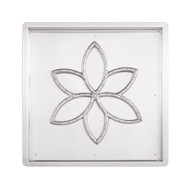Why You Need a Burner Pan in Your Gas Fire Pit Build
Posted by NFI Certified Gas Fire Pit Expert on Apr 24th 2025
Why You Need a Burner Pan in Your Gas Fire Pit Build
Whether you’re a seasoned pro or tackling a backyard fire feature as a DIY project, one component you shouldn’t skip is the burner pan. It might not be the flashiest part of your fire pit setup, and you may even ask why you should spend money on it, but it plays a critical role in both safety and performance.
What Is a Burner Pan?
A burner pan is a shaped metal tray—usually stainless steel or aluminum—that supports the burner and fire media (like lava rock or fire glass) inside your fire pit. It’s installed just below the top edge of your fire feature and provides both structure and spacing for everything else to work properly.
Three Main Styles: Lipped, Lipless, and Flat
Burner pans come in two styles, and how they’re installed makes a difference:
- Lipped Burner Pans: These have a visible lip that rests on top of the fire pit structure. They're easier to install since they don’t need separate support underneath. However, with larger sizes, there's a higher risk of warping or bending over time.
- Lipless Burner Pans: These are similar in construction to the lipped pans mentioned above in the fact that they have a side wall, but they do not have a lip on top. This allows for a cleaner finished look, provides side mounting options, and offers a "floating" pan that can contain the media in instances where the pan does not immediately border the interior wall of the fire pit structure.
- Flat Burner Pans: These are designed to sit inside the fire pit, fully hidden under the media. They must be supported from underneath—usually with metal struts or block ledges built into the structure.
In all cases, the shape of the pan should match the burner and fire pit: round, square, or rectangular (linear). Standard sizes are available, but custom pans can be made if you’re working on something outside the norm. The pan is most commonly sized to fit the inner dimensions of the fire pit opening, with enough clearance for fitment and installation.
Why a Burner Pan Matters
Skipping the burner pan can lead to serious issues—here’s why it matters:
- Stabilizes the Burner: A properly fitted pan keeps the burner firmly in place, reducing movement that could stress the gas line and potentially cause leaks.
- Supports the Media: It holds the fire glass, lava rock, or other decorative media, keeping it where it belongs and helping distribute flame evenly. Explore fire pit media options.
- Eliminates the Need to Backfill: You should never fill up your fire pit with gravel or stone to support the burner. Instead, leave that area open to maintain airflow and allow for proper gas line routing and ventilation, and build in proper support for the pan.
- Provides Critical Airspace: That open space beneath the pan helps house your gas stub, ignition system, and other connections. It also ensures there's room for any leaked gas or condensation to escape safely—especially when paired with opposing vent openings on the fire pit.
The Risks of Skipping It
Not using a burner pan can lead to:
- Unsafe burner placement
- Blocked airflow and poor combustion
- Higher risk of gas buildup
- Warping of the burner setup over time
- Difficulty supporting fire media evenly
Wrap-Up
Whether you’re installing a Plug & Play setup or building something fully custom, don’t overlook the burner pan. It’s a simple piece that goes a long way in making your gas fire pit safe, functional, and beautiful.
Need help choosing the right burner and pan combo for your project? Flame Source can guide you through sizing, shape, and support options—whether you're a trade pro or weekend warrior.

